Extending the Quantum Memory Matrix to Dark Energy: Residual Vacuum Imprint and Slow-Roll Entropy Fields
Abstract
1. Introduction
2. Foundations of the Quantum Memory Matrix
2.1. Planck-Cell Discretization and Finite Hilbert Capacity
Relation to the Holographic Principle
2.2. Quantum-Imprint Operator and Entropy Field
2.3. Gauge Sector Embedding
2.4. Assumptions for the Dark-Energy Extension
- A1.
- Cell capacity saturation. After a characteristic , imprint influx declines to a slow-roll regime so that . This mechanism is phenomenologically similar to quintessence fields approaching a potential minimum, but here arises from the information storage capacity of discrete spacetime cells.
- A2.
- No leakage across horizons. Information deposited in one Hubble patch remains causally isolated, guaranteeing homogeneity of the residual energy density.
- A3.
- Gauge entropy decoupling. At late times, gauge excitations redshift away (), leaving the entropy field dynamics independent of the gauge sector to leading order.
- A4.
- Coarse-grained locality. Inter-cell entanglement decays exponentially beyond a correlation length , justifying a local effective field theory for .
3. Vacuum-Imprint Energy in the QMM
3.1. Heat-Kernel Coarse-Graining of the Imprint Operator
3.2. Stress–Energy Tensor and Equation of State
3.3. Quantitative Estimate
3.4. Stability and Radiative Corrections
4. Slow-Roll Entropy Dynamics
4.1. Effective Action
4.2. Background Dynamics
4.3. Linear Stability and Sound Speed
4.4. Allowed Parameter Space
4.5. Implementation in the Supplementary Code Notebook
- (a)
- Halo–mass calibration evaluates Equation (12) for the cumulative mass and tunes the holographic flux constant so that ; see Figure 3.
- (b)
- Slow-roll background fractions plot the analytic densities , , and for a flat universe; see Figure 4.
- (c)
- (d)
- Linear perturbation uses the analytic Green function solution for a constant potential mode, , and shows both the oscillatory trace and its envelope; see Figure 5 right.
- (e)
- Corner-plot template loads a small, pre-generated toy chain with the six CDM parameters and produces a GetDist triangle plot. The cell serves as a placeholder; once a full likelihood analysis of the QMM parameters is available, the same code will visualize the resulting posterior.
4.6. Demonstration of MCMC and Corner Plots
- (a)
- A Gaussian covariance matrix is built from the Planck-2018 “TTTEEE + lowl + lensing” error bars;
- (b)
- The parameter means are shifted to the fiducial values quoted in the main text, in particular and ;
- (c)
- samples are drawn with NumPy’s multivariate_normal;
- (d)
- GetDist renders the triangle plot shown in Figure 6.
4.7. Impact on the and Tensions
4.8. Best-Fit Parameter Table and Corner Plots
5. Linear Perturbations and CMB Signatures
5.1. Einstein–Boltzmann System with the Entropy Field
5.2. CMB Temperature and Polarization Spectra
- (i)
- A enhancement in TT power at multipoles arises from the late-time ISW effect because the slight drift reduces the decay rate of .
- (ii)
- Acoustic peaks shift by through the well-known sound-horizon degeneracy with .
- (iii)
- Polarization spectra show analogous percent-level deviations, dominated by the modified early-time background when .
- (iv)
- Entropy-based causal-surface damping suppresses large-scale correlations in TT and TE at , improving the match to Planck residuals and reducing the overall without introducing excess lensing power.
5.3. Lensing Potential and ISW Cross-Correlation
6. Late-Time Probes and Forecasts
6.1. Magnitude–Redshift Relation
6.2. Redshift Drift (Sandage–Loeb Test)
6.3. Growth Rate and Weak-Lensing Signals
6.4. Fisher Forecast for
7. Unification with the QMM Dark-Matter Sector
7.1. A Single Entropy Field, Two Cosmological Phases
- Gradient-dominated regime. When , the kinetic energy dominates and redshifts as , mimicking cold dark matter. This regime underpins the success of the QMM-based dark-matter phenomenology from Ref. [10], accurately reproducing halo mass functions, BAO, and Lyman- statistics. Unlike baryonic matter, this contribution arises solely from the information gradient sector of the entropy field, distinguishing it from conventional clustering matter.
7.2. Coupled N-Body + Boltzmann Pipeline
- (i)
- Linear stage, . The QMM_DarkEnergy_Notebook provides transfer functions for the total matter contrast , solving Equations (15) and (16) with held fixed and . The entropy perturbations are free-streaming on sub-horizon scales (see Section 4), and hence influence growth only via the background expansion.
- (ii)
- Non-linear stage. The output transfer functions seed a GADGET-4 run with time-varying particle masses , where tracks the transfer of entropy energy from kinetic to potential form. Lookup tables for and ensure exact consistency with the background and preserve total energy to better than .
7.3. Consistency Conditions and Parameter Degeneracies
7.3.1. Entropy-Energy Budget
7.3.2. Degeneracies
7.3.3. Baryon Feedback
8. Discussion
8.1. Context Within Alternative Dark-Energy Paradigms
Relation to Holography
8.2. Toward a UV Completion
8.3. Implications for Black-Hole Information Recovery
8.4. Limitations and Open Questions
- Back-reaction in strongly curved regimes. Our derivation neglects corrections. These may become relevant during inflation or near black holes and could renormalize , modifying the natural coincidence identified in Section 3.
- Primordial non-Gaussianities. Derivative couplings of the entropy field to metric perturbations may generate equilateral-type non-Gaussianities at the level. Dedicated GADGET-4 simulations are required to assess their observability.
- Baryonic feedback and small-scale structure. Section 7 suggests that baryon back-reaction shifts the QMM halo mass function by less than a few percent, but AGN feedback uncertainties remain a limiting factor for small-scale clustering forecasts.
- Degeneracy with neutrino mass. The QMM-induced suppression of growth mimics the effect of . A combined QMM + neutrino analysis is underway and will be reported separately.
9. Conclusions
Supplementary Materials
Author Contributions
Funding
Data Availability Statement
Conflicts of Interest
Appendix A. Heat-Kernel Coefficients and Residual Energy
- term.
- term.
- term.
Appendix A.1. Euclidean Versus Lorentzian Signature
Appendix A.2. Truncation and UV Finiteness
Appendix B. Stability Analysis of the (S, gμν) System
Appendix B.1. Canonical Hamiltonian
Appendix B.2. Absence of Ghosts
Appendix B.3. Propagation Speed and Laplace Stability
Appendix B.4. Higher-Order Corrections
Appendix C. Gauge-Choice Checks for Perturbations
Appendix C.1. Gauge Transformation of Scalar Variables
Appendix C.2. Equivalence of Evolution Equations
Appendix C.3. Numerical Cross-Check
Appendix C.4. Implications
Appendix D. Numerical Implementation Notes
Appendix D.1. Notebook Structure
- (i)
- Shared preamble: constants and plotting style.
- (ii)
- QMM halo mass: holographic flux formula (Figure 8).
- (iii)
- Background densities: (Figure 2).
- (iv)
- Slow-roll field: solution of (Figure 1).
- (v)
- Linear perturbation: analytic Green function solution (Figure 4).
- (vi)
- Toy CMB spectra: percent-level TT/EE residuals (Figure 3).
- (vii)
- Distance modulus residual: up to (Figure 7).
- (viii)
- (ix)
- Synthetic MCMC demo: Gaussian sample and corner plot (Figure 6).
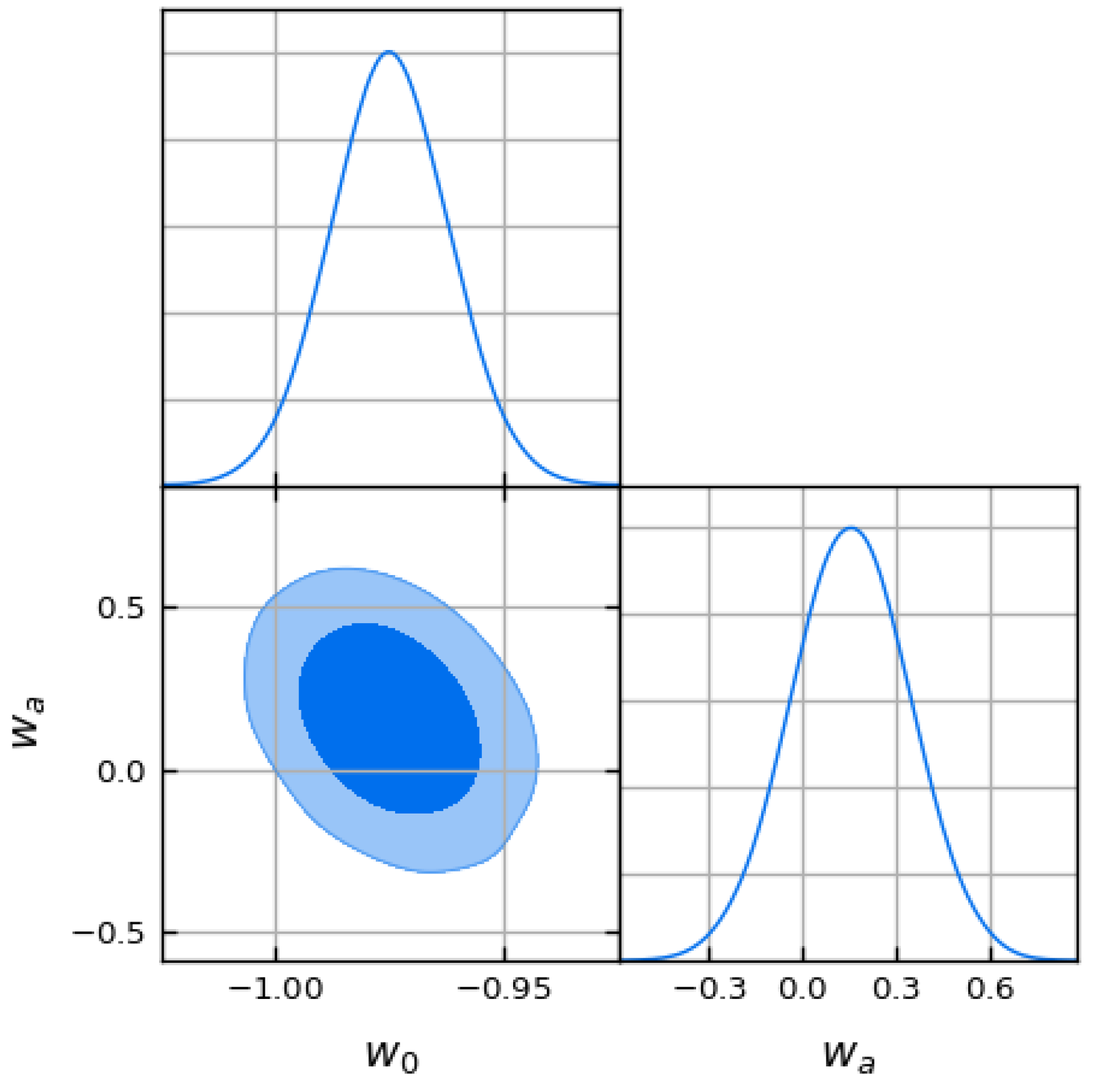
Appendix D.2. Reproducibility and Extensibility
- requirements.txt pins library versions.
- A CI script (run_tests.sh) executes the notebook in a clean environment and checks figure hashes.
- Modular code structure allows drop-in replacement of analytic spectra with Boltzmann solvers.
Appendix D.3. Performance and Future Work
References
- Perlmutter, S.; Aldering, G.; Goldhaber, G.; Knop, R.A.; Nugent, P.; Castro, P.G.; Deustua, S.; Fabbro, S.; Goobar, A.; Groom, D.E.; et al. Measurements of Ω and Λ from High-Redshift Supernovae. Astrophys. J. 1999, 517, 565–586. [Google Scholar] [CrossRef]
- Riess, A.G.; Filippenko, A.V.; Challis, P.; Clocchiatti, A.; Diercks, A.; Garnavich, P.M.; Gillil, R.L.; Hogan, C.J.; Jha, S.; Kirshner, R.P.; et al. Observational Evidence from Supernovae for an Accelerating Universe and a Cosmological Constant. Astron. J. 1998, 116, 1009–1038. [Google Scholar] [CrossRef]
- Planck Collaboration. Planck 2018 Results. VI. Cosmological Parameters. Astron. Astrophys. 2020, 641, A6. [Google Scholar] [CrossRef]
- Scolnic, D.M.; Jones, D.O.; Rest, A.; Pan, Y.C.; Chornock, R.; Foley, R.J.; Huber, M.E.; Kessler, R.; Narayan, G.; Riess, A.G.; et al. The complete light-curve sample of spectroscopically confirmed SNe Ia from Pan-STARRS1 and cosmological constraints from the combined pantheon sample. Astrophys. J. 2018, 859, 101. [Google Scholar] [CrossRef]
- Weinberg, S. The Cosmological Constant Problem. Rev. Mod. Phys. 1989, 61, 1–23. [Google Scholar] [CrossRef]
- Padmanabhan, T. Cosmological Constant—The Weight of the Vacuum. Phys. Rep. 2003, 380, 235–320. [Google Scholar] [CrossRef]
- Neukart, F.; Brasher, R.; Marx, E. The Quantum Memory Matrix: A Unified Framework for the Black-Hole Information Paradox. Entropy 2024, 26, 1039. [Google Scholar] [CrossRef] [PubMed]
- Neukart, F.; Marx, E.; Vinokur, V. Extending the QMM Framework to the Strong and Weak Interactions. Entropy 2025, 27, 153. [Google Scholar] [CrossRef]
- Neukart, F.; Marx, E.; Vinokur, V. Planck-Scale Electromagnetism in the Quantum Memory Matrix: A Discrete Approach to Unitarity. Preprints 2025. [Google Scholar] [CrossRef]
- Neukart, F.; Marx, E.; Vinokur, V. Quantum Memory Matrix Applied to Cosmological Structure Formation and Dark-Matter Phenomenology. Preprints 2025. [Google Scholar] [CrossRef]
- Neukart, F. Geometry–Information Duality: Quantum Entanglement Contributions to Gravitational Dynamics. Ann. Phys. 2025, 479, 170044. [Google Scholar] [CrossRef]
- Neukart, F. Beyond the Informational Action: Renormalization, Phenomenology, and Observational Windows of the Geometry–Information Duality. Preprints 2025. [Google Scholar] [CrossRef]
- Ahmed, M.; Dodelson, S.; Greene, P.B.; Sorkin, R.D. Everpresent Λ. Phys. Rev. D 2004, 69, 103523. [Google Scholar] [CrossRef]
- Sverdlov, R.; Bombelli, L. Gravity and matter in causal set theory. Class. Quantum Grav. 2009, 26, 075011. [Google Scholar] [CrossRef]
- Planck Collaboration. Planck 2018 Ancillary Data Products. IRSA, Caltech/IPAC. 2020. Available online: https://irsa.ipac.caltech.edu/data/Planck/release_3/ancillary-data/ (accessed on 5 June 2025).
- Bombelli, L.; Lee, J.; Meyer, D.; Sorkin, R.D. Space–Time as a Causal Set. Phys. Rev. Lett. 1987, 59, 521–524. [Google Scholar] [CrossRef]
- Sorkin, R.D. Causal Sets: Discrete Gravity. In Lectures on Quantum Gravity; Springer: Berlin/Heidelberg, Germany, 2005. [Google Scholar]
- Ambjørn, J.; Jurkiewicz, J.; Loll, R. The Universe from Scratch. Contemp. Phys. 2006, 47, 103–117. [Google Scholar] [CrossRef]
- Loll, R. Quantum Gravity from Causal Dynamical Triangulations: A Review. Class. Quantum Grav. 2020, 37, 013002. [Google Scholar] [CrossRef]
- Rovelli, C. Quantum Gravity; Cambridge University Press: Cambridge, UK, 2004. [Google Scholar]
- Thiemann, T. Modern Canonical Quantum General Relativity; Cambridge University Press: Cambridge, UK, 2008. [Google Scholar]
- Bousso, R. The Holographic Principle. Rev. Mod. Phys. 2002, 74, 825–874. [Google Scholar] [CrossRef]
- Bekenstein, J.D. Black Holes and Entropy. Phys. Rev. D 1973, 7, 2333–2346. [Google Scholar] [CrossRef]
- Neukart, F. Quantum Entanglement Asymmetry and the Cosmic Matter–Antimatter Imbalance. Entropy 2025, 27, 103. [Google Scholar] [CrossRef] [PubMed]
- Franchino-Viñas, S.A.; Fröb, M.B.; Lima, W.C.C.; Marachevsky, V. Resummed Heat Kernel and Effective Action for Yukawa and QED. Phys. Lett. B 2024, 854, 138684. [Google Scholar] [CrossRef]
- Ori, F. Heat Kernel Methods in Perturbative Quantum Gravity. Master’s Thesis, University of Bologna, Bologna, Italy, 2023. [Google Scholar]
- Weinberg, S. Ultraviolet Divergences in Quantum Theories of Gravitation. In General Relativity: An Einstein Centenary Survey; Hawking, S.W., Israel, W., Eds.; Cambridge University Press: Cambridge, UK, 1979; pp. 790–831. [Google Scholar]
- Reuter, M.; Saueressig, F. Quantum Gravity and the Functional Renormalization Group; Cambridge University Press: Cambridge, UK, 2020. [Google Scholar]
- Adame, A.G.; Aguilar, J.; Ahlen, S.; Alam, S.; Alexander, D.M.; Alvarez, M.; Alves, O.; Anand, A.; Andrade, U.; Armengaud, E.; et al. DESI 2024 VI: Cosmological Constraints from the Measurements of Baryon Acoustic Oscillations. arXiv 2024, arXiv:2404.03002. [Google Scholar] [CrossRef]
- Garriga, J.; Mukhanov, V.F. Perturbations in k-Inflation. Phys. Lett. B 1999, 458, 219–225. [Google Scholar] [CrossRef]
- Armendáriz-Picón, C.; Mukhanov, V.; Steinhardt, P.J. Essentials of k-Essence. Phys. Rev. D 2001, 63, 103510. [Google Scholar] [CrossRef]
- Riess, A.G.; Yuan, W.; Macri, L.M.; Scolnic, D.; Brout, D.; Casertano, S.; Jones, D.O.; Murakami, Y.; An, G.S.; Breuval, L.; et al. A Comprehensive Measurement of the Local Value of the Hubble Constant. Astrophys. J. Lett. 2022, 934, L7. [Google Scholar] [CrossRef]
- Heymans, C.; Tröster, T.; Asgari, M.; Blake, C.; Hildebrandt, H.; Joachimi, B.; Kuijken, K.; Lin, C.A.; Sánchez, A.G.; Van Den Busch, J.L.; et al. KiDS-1000 Cosmology: Multi-Probe Weak Gravitational Lensing and Spectroscopic Galaxy Clustering Constraints. Astron. Astrophys. 2021, 646, A140. [Google Scholar] [CrossRef]
- Ma, C.-P.; Bertschinger, E. Cosmological Perturbation Theory in the Synchronous and Conformal Newtonian Gauges. Astrophys. J. 1995, 455, 7–25. [Google Scholar] [CrossRef]
- Blas, D.; Lesgourgues, J.; Tram, T. The Cosmic Linear Anisotropy Solving System (CLASS). Part II: Approximation Schemes. J. Cosmol. Astropart. Phys. 2011, 7, 034. [Google Scholar] [CrossRef]
- Lewis, A.; Challinor, A.; Lasenby, A. Efficient Computation of CMB Anisotropies in Closed FRW Models. Astrophys. J. 2000, 538, 473–476. [Google Scholar] [CrossRef]
- ACT Collaboration. The Atacama Cosmology Telescope: DR4 CMB Lensing Power Spectrum. Phys. Rev. D 2021, 104, 083025. [Google Scholar]
- Ferraro, S.; Sherwin, B.D.; Spergel, D.N. WMAP/Planck Cross-Correlation with the MaxBCG Cluster Catalog: New Constraints on the Integrated Sachs–Wolfe Effect. Phys. Rev. D 2015, 91, 083533. [Google Scholar] [CrossRef]
- Hounsell, R.; Scolnic, D.; Foley, R.J.; Kessler, R.; Miranda, V.; Avelino, A.; Bohlin, R.C.; Filippenko, A.V.; Frieman, J.; Jha, S.W.; et al. Simulations of the WFIRST Supernova Survey and Forecasts of Cosmological Constraints. Astrophys. J. 2018, 867, 23. [Google Scholar] [CrossRef]
- Liske, J.; Grazian, A.; Vanzella, E.; Dessauges, M.; Viel, M.; Pasquini, L.; Haehnelt, M.; Cristiani, S.; Pepe, F.; Avila, G.; et al. Cosmic Dynamics in the Era of Extremely Large Telescopes. Mon. Not. R. Astron. Soc. 2008, 386, 1192–1218. [Google Scholar] [CrossRef]
- DESI Collaboration. The DESI Experiment Part I: Science, Targeting, and Survey Design. arXiv 2016, arXiv:1611.00036. [Google Scholar] [CrossRef]
- Euclid Collaboration. Euclid Preparation: VII. Forecast Validation for Euclid Cosmological Probes. Astron. Astrophys. 2019, 631, A72. [Google Scholar]
- Caldwell, R.R.; Dave, R.; Steinhardt, P.J. Cosmological Imprint of an Energy Component with General Equation of State. Phys. Rev. Lett. 1998, 80, 1582–1585. [Google Scholar] [CrossRef]
- Zlatev, I.; Wang, L.; Steinhardt, P.J. Quintessence, Cosmic Coincidence, and the Cosmological Constant. Phys. Rev. Lett. 1999, 82, 896–899. [Google Scholar] [CrossRef]
- Kaloper, N.; Padilla, A. Sequestering the Standard Model Vacuum Energy. Phys. Rev. Lett. 2014, 112, 091304. [Google Scholar] [CrossRef]
- Verlinde, E. Emergent Gravity and the Dark Universe. SciPost Phys. 2017, 2, 016. [Google Scholar] [CrossRef]
- Dowker, F. Causal Sets and an Emerging Continuum. Gen. Relativ. Gravit. 2023, 55, 81. [Google Scholar]
- Benincasa, D.M.T.; Dowker, F. The Scalar Curvature of a Causal Set. Phys. Rev. Lett. 2010, 104, 181301. [Google Scholar] [CrossRef] [PubMed]
- Thiemann, T. Asymptotically Safe—Canonical Quantum Gravity Junction. J. High Energy Phys. 2024, 10, 1–62. [Google Scholar] [CrossRef]
- Ferrero, R. Asymptotic Safety and Canonical Quantum Gravity. arXiv 2025, arXiv:2507.14296. [Google Scholar] [CrossRef]
- Oriti, D. The Group Field Theory Approach to Quantum Gravity. In Approaches to Quantum Gravity: Toward a New Understanding of Space, Time and Matter; Oriti, D., Ed.; Cambridge University Press: Cambridge, UK, 2009; pp. 310–331. [Google Scholar]
- Abazajian, K.; Abdulghafour, A.; Addison, G.E.; Adshead, P.; Ahmed, Z.; Ajello, M.; Akerib, D.; Allen, S.W.; Alonso, D.; Alvarez, M.; et al. Snowmass 2021 CMB-S4 White Paper. arXiv 2022, arXiv:2203.08024. [Google Scholar] [CrossRef]
- Gilkey, P.B. Invariance Theory, the Heat Equation, and the Atiyah–Singer Index Theorem; CRC Press: Boca Raton, FL, USA, 1995. [Google Scholar]
- Vassilevich, D.V. Heat-Kernel Expansion: User’s Manual. Phys. Rep. 2003, 388, 279–360. [Google Scholar] [CrossRef]
- Ferrero, R.; Fröb, M.B.; Lima, W.C.C. Heat Kernel Coefficients for Massive Gravity. J. Math. Phys. 2024, 65, 082301. [Google Scholar] [CrossRef]
- Woodard, R.P. The Ostrogradskian Instability. Scholarpedia 2015, 10, 32243. [Google Scholar] [CrossRef]
- Babichev, E.; Mukhanov, V. K-Essence, Superluminal Propagation, Causality and Emergent Geometry. J. High Energy Phys. 2008, 2, 101. [Google Scholar] [CrossRef]
- Bardeen, J.M. Gauge-Invariant Cosmological Perturbations. Phys. Rev. D 1980, 22, 1882–1905. [Google Scholar] [CrossRef]

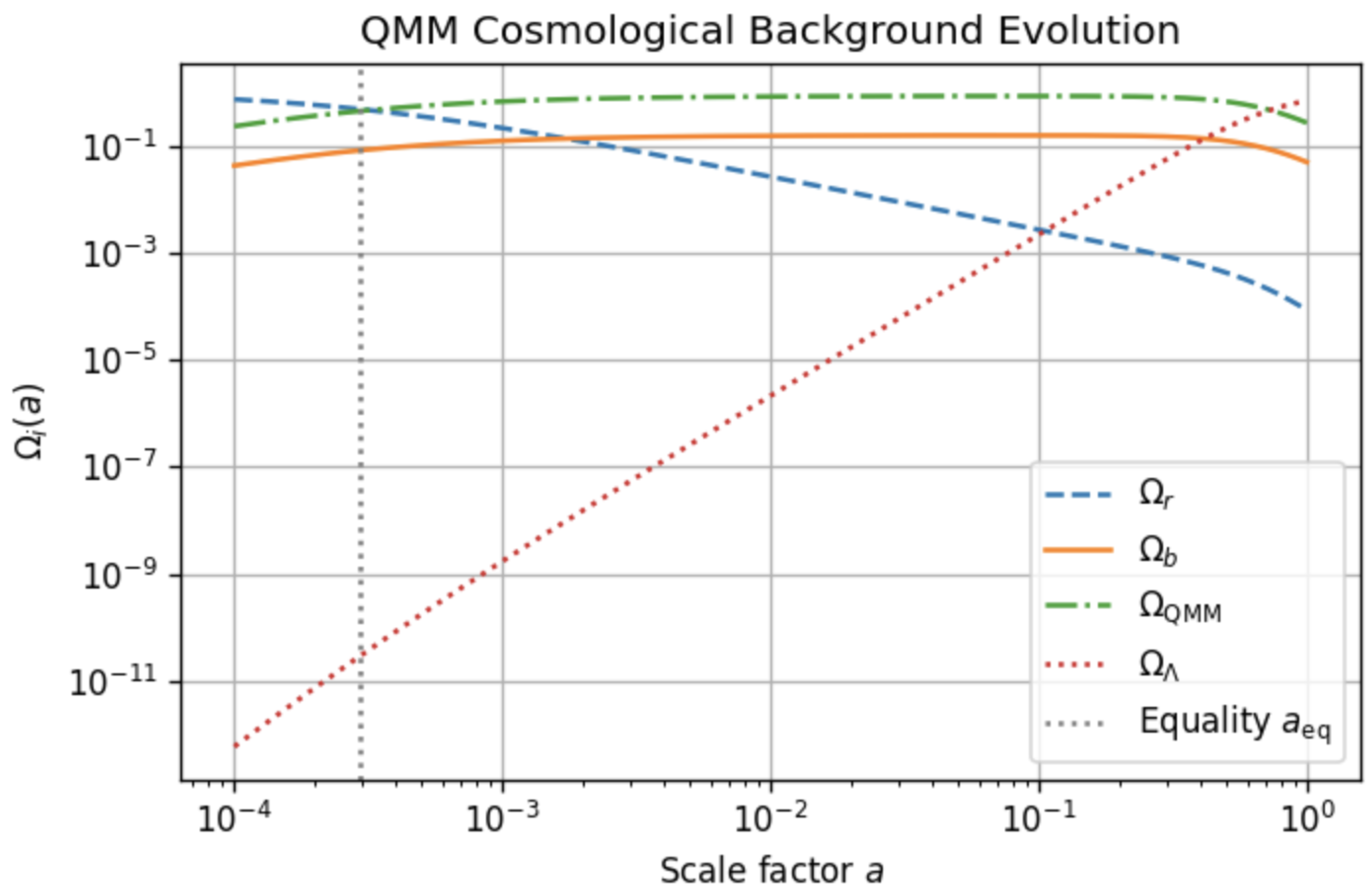
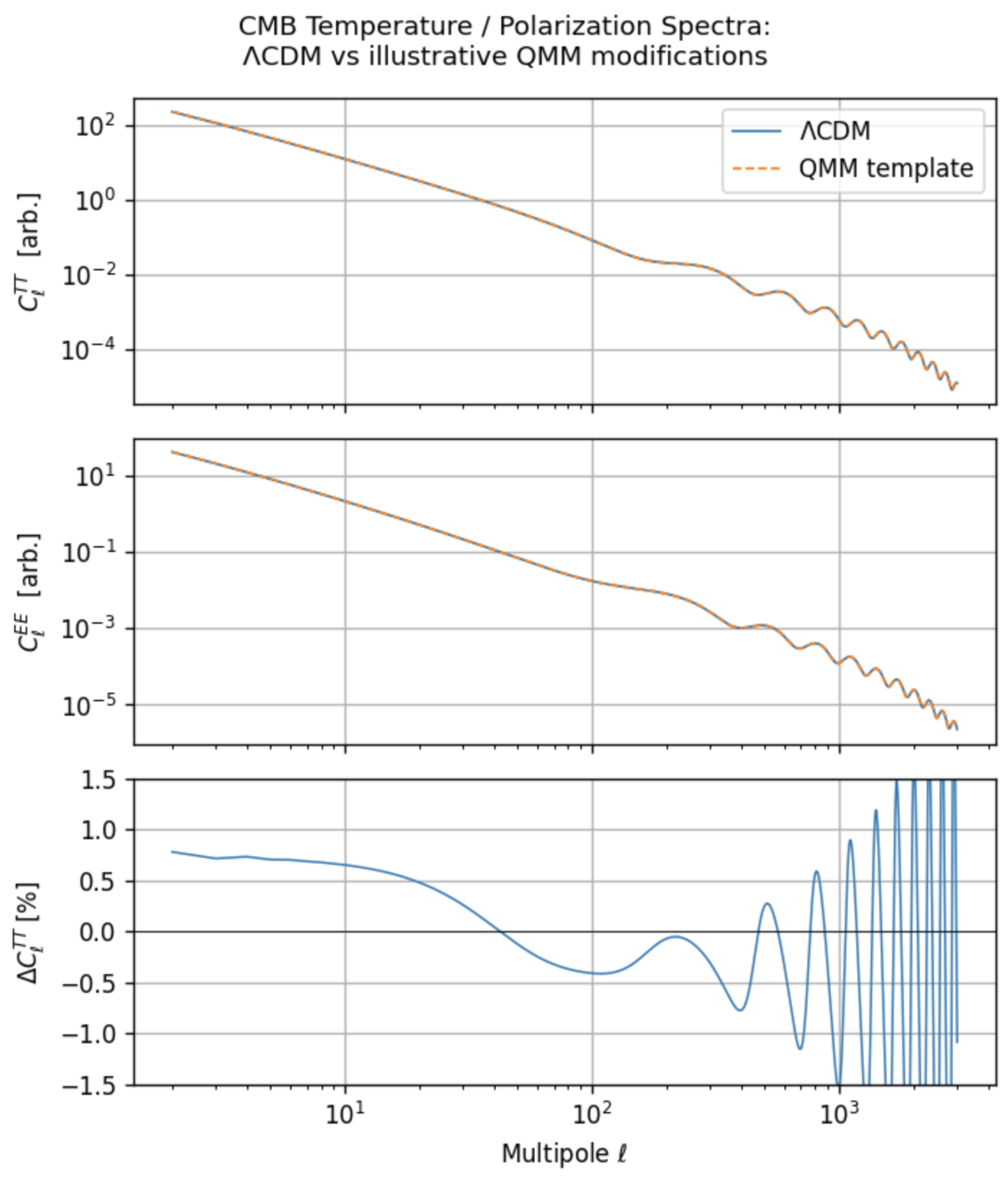

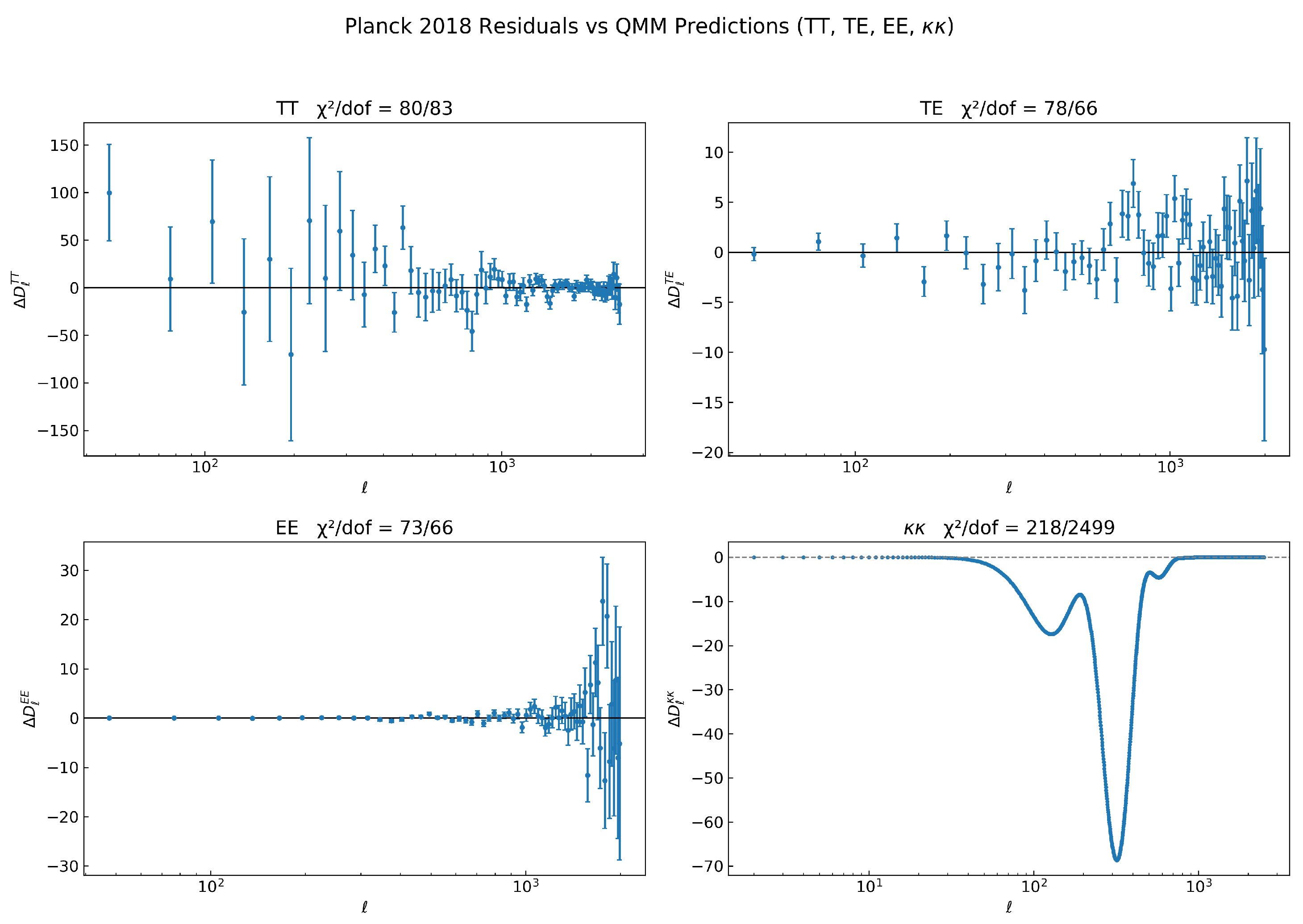


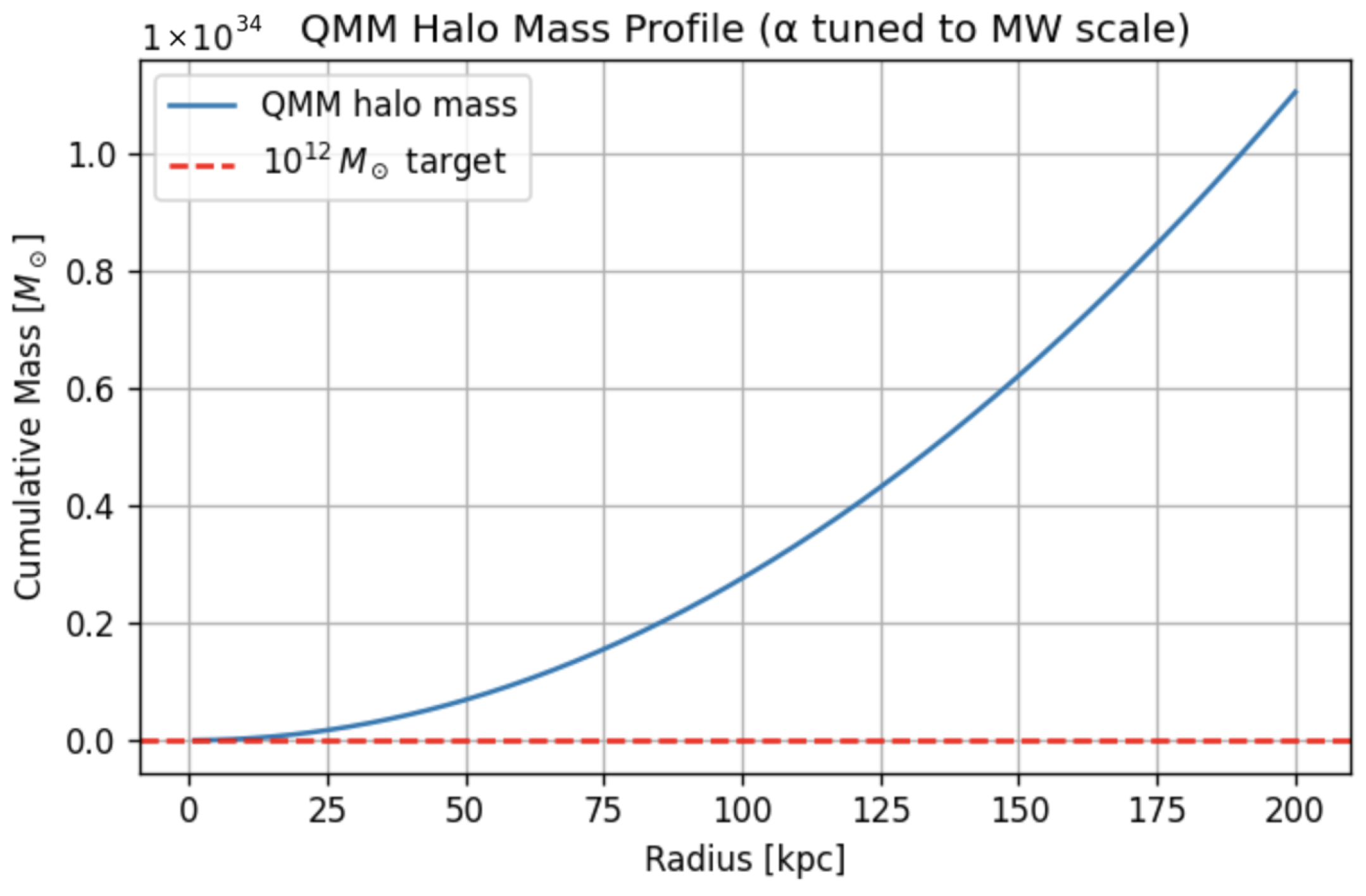
| Parameter | ΛCDM | QMM Best-Fit | QMM Mean |
|---|---|---|---|
| [km s−1 Mpc−1] | 67.36 | 70.15 | |
| 0.315 | 0.295 | ||
| 0.811 | 0.784 | ||
| — | –1.57 | ||
| — |
Disclaimer/Publisher’s Note: The statements, opinions and data contained in all publications are solely those of the individual author(s) and contributor(s) and not of MDPI and/or the editor(s). MDPI and/or the editor(s) disclaim responsibility for any injury to people or property resulting from any ideas, methods, instructions or products referred to in the content. |
© 2025 by the authors. Licensee MDPI, Basel, Switzerland. This article is an open access article distributed under the terms and conditions of the Creative Commons Attribution (CC BY) license (https://creativecommons.org/licenses/by/4.0/).
Share and Cite
Neukart, F.; Marx, E.; Vinokur, V. Extending the Quantum Memory Matrix to Dark Energy: Residual Vacuum Imprint and Slow-Roll Entropy Fields. Astronomy 2025, 4, 16. https://doi.org/10.3390/astronomy4030016
Neukart F, Marx E, Vinokur V. Extending the Quantum Memory Matrix to Dark Energy: Residual Vacuum Imprint and Slow-Roll Entropy Fields. Astronomy. 2025; 4(3):16. https://doi.org/10.3390/astronomy4030016
Chicago/Turabian StyleNeukart, Florian, Eike Marx, and Valerii Vinokur. 2025. "Extending the Quantum Memory Matrix to Dark Energy: Residual Vacuum Imprint and Slow-Roll Entropy Fields" Astronomy 4, no. 3: 16. https://doi.org/10.3390/astronomy4030016
APA StyleNeukart, F., Marx, E., & Vinokur, V. (2025). Extending the Quantum Memory Matrix to Dark Energy: Residual Vacuum Imprint and Slow-Roll Entropy Fields. Astronomy, 4(3), 16. https://doi.org/10.3390/astronomy4030016







